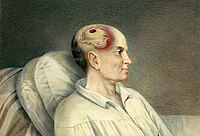
Photo from wikipedia
This study examined the performance of serum ubiquitin C-terminal hydrolase (UCH-L1) in detecting traumatic intracranial lesions on computed tomography (CT) scan (+CT) in children and youth with mild and moderate… Click to show full abstract
This study examined the performance of serum ubiquitin C-terminal hydrolase (UCH-L1) in detecting traumatic intracranial lesions on computed tomography (CT) scan (+CT) in children and youth with mild and moderate TBI (mmTBI) and assessed its performance in trauma control patients without head trauma. This prospective cohort study enrolled children and youth presenting to three level 1 trauma centers after blunt head trauma and a Glasgow Coma Scale (GCS) score of 9-15 as well as trauma control patients with GCS 15 that did not have blunt head trauma. The primary outcome measure was the presence of intracranial lesions on initial CT scan. Blood samples were obtained in all patients within 6 h of injury and measured by enzyme-linked immunosorbent assay ELISA for UCH-L1 (ng/mL). A total of 256 children and youth were enrolled in the study and had serum samples drawn within 6 h of injury for analysis; 196 had blunt head trauma and 60 were trauma controls. CT scan of the head was performed in 151 patients and traumatic intracranial lesions on CT scan were evident in 17 (11%), all of whom had a GCS of 13-15. The area under the receiver operating characteristic curve (AUC) for UCH-L1 in detecting children and youth with traumatic intracranial lesions on CT was 0.83 (95% confidence interval [CI], 0.73-0.93). In those presenting with a GCS of 15, the AUC for detecting lesions was 0.83 (95% CI, 0.72-0.94). Similarly, in children under 5 years of age, the AUC was 0.79 (95% CI, 0.59-1.00). Performance for detecting intracranial lesions at a UCH-L1 cut-off level of 0.18 ng/mL yielded a sensitivity of 100%, a specificity of 47%, and a negative predictive value of 100%. UCH-L1 showed good performance in infants and toddlers younger than 5 years and performed well in children and youth with a GCS score of 15. Before clinical application, further study in larger cohort of children and youth with mild TBI is warranted.
Journal Title: Journal of neurotrauma
Year Published: 2017
Link to full text (if available)
Share on Social Media: Sign Up to like & get
recommendations!